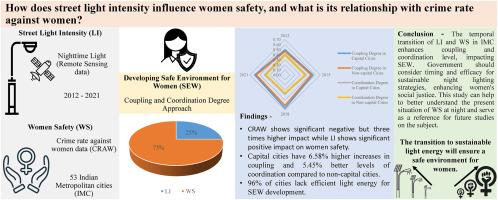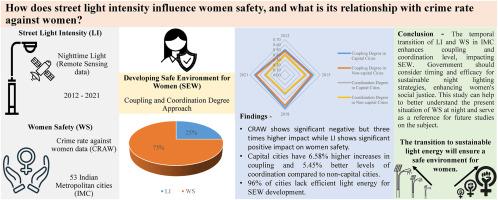Coupling and coordination association between night light intensity and women safety – A comparative assessment of Indian metropolitan cities
IF 9.7
1区 环境科学与生态学
Q1 ENGINEERING, ENVIRONMENTAL
引用次数: 0
Abstract
Street lighting is an important aspect influencing women safety (WS) at night. Increased crime rate against women (CRAW) in Indian metropolitan areas (IMC) have a negative impact on the establishment of a safe environment for women (SEW). Women feel insecure when traveling alone because visibility is poor at night on urban streets. In order to create a safe environment and promote social justice, the study aims to analyze the impact of night light intensity (LI) on WS. The research uses remote sensing nighttime light (NTL) data to assess the temporal transition of LI and uses the coupling and coordination degree (CCD) technique to analyze the interaction between LI and WS in 53 IMC from 2012 to 2021. The following conclusions are drawn - first, LI has a higher temporal transition than CRAW in capital cities than non-capital cities due to better streetlight infrastructure. Second, CRAW shows a significant negative but three times higher impact while LI shows a significant positive impact on women safety. Third, Capital cities have 6.58% higher increases in coupling and 5.45% better levels of coordination compared to non-capital cities. Cities with high LI and high WS have a good level of coupling and coordination. Lastly, it is estimated that 96% of cities lack efficient light energy for SEW development. This study also makes policy recommendations to assist decision-makers in developing ways to improve the SEW by prioritizing cities. To move further, future studies should combine different time zones, such as daytime LI and crime rate, with other demographic groupings. This study can help to better understand the present situation of WS at night and serve as a reference for future studies on the subject.


夜间照明强度与女性安全之间的耦合与协调关系--印度大都市的比较评估
街道照明是影响夜间妇女安全(WS)的一个重要方面。印度大都市地区针对妇女的犯罪率(CRAW)上升对营造妇女安全环境(SEW)产生了负面影响。由于城市街道夜间能见度低,妇女独自出行时会感到不安全。为了创造一个安全的环境并促进社会公正,本研究旨在分析夜间光照强度(LI)对 WS 的影响。研究使用遥感夜间光照(NTL)数据来评估 LI 的时间转换,并使用耦合与协调度(CCD)技术来分析 2012 年至 2021 年 53 个 IMC 中 LI 与 WS 之间的相互作用。得出以下结论--首先,由于路灯基础设施较好,在省会城市,LI 的时间转换高于 CRAW。其次,CRAW 对妇女安全的影响显著为负,但高出三倍,而 LI 对妇女安全的影响显著为正。第三,与非首都城市相比,首都城市的耦合度提高了 6.58%,协调水平提高了 5.45%。高 LI 和高 WS 的城市具有良好的耦合和协调水平。最后,据估计,96% 的城市缺乏促进 SEW 发展的高效光能。本研究还提出了政策建议,以帮助决策者通过优先考虑城市来制定改善 SEW 的方法。为了更进一步,未来的研究应结合不同的时区,如日间 LI 和犯罪率,以及其他人口分组。本研究有助于更好地了解夜间 WS 的现状,并为今后的相关研究提供参考。
本文章由计算机程序翻译,如有差异,请以英文原文为准。
求助全文
约1分钟内获得全文
求助全文
来源期刊

Journal of Cleaner Production
环境科学-工程:环境
CiteScore
20.40
自引率
9.00%
发文量
4720
审稿时长
111 days
期刊介绍:
The Journal of Cleaner Production is an international, transdisciplinary journal that addresses and discusses theoretical and practical Cleaner Production, Environmental, and Sustainability issues. It aims to help societies become more sustainable by focusing on the concept of 'Cleaner Production', which aims at preventing waste production and increasing efficiencies in energy, water, resources, and human capital use. The journal serves as a platform for corporations, governments, education institutions, regions, and societies to engage in discussions and research related to Cleaner Production, environmental, and sustainability practices.
 求助内容:
求助内容: 应助结果提醒方式:
应助结果提醒方式:


